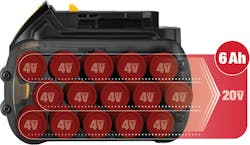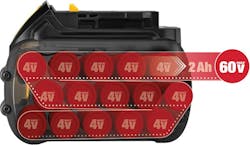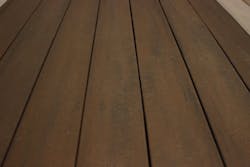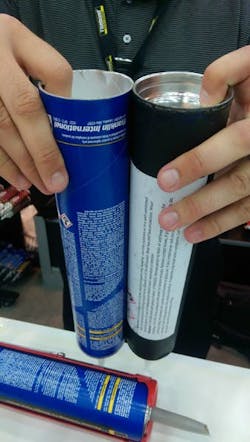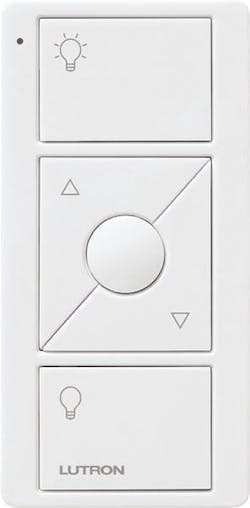Innovative Products
All new products should have a visionary design, excellent craftsmanship, and answer a specific need for the end user. But they don’t. Too often, a mandate to bring new items to the market trumps the values of quality and relevance.
That’s why we’re focusing here on four great products that are truly innovative in their field. Some are brand new, while others have been available for a number of months, but all of them are standouts that deserve your attention.
What is FlexVolt?
This summer, DeWalt unveiled its FlexVolt system, which uses a battery that automatically switches between 18 or 54 volts (20 or 60 volts nominal), without user input.
The secret is in the wiring. The innovation solves two problems for DeWalt: It improves performance of large brushless motors, which research shows run better at higher voltages; and it enables backward compatibility with the company’s existing 20V Max system.
Lithium-ion cells are typically wired either in series to increase the voltage or in parallel for greater amp hours. FlexVolt batteries are wired both in series and in parallel, switching to match the tool being used via the electronics in the brushless motor. That means FlexVolt batteries offer extended run time for existing DeWalt 20V Max tools and are the basis for a new line of 60V Max tools, which can combine two FlexVolt batteries delivering nominal 120 volts.
Parallel wired = more amp hours. A typical DeWalt 20V Max tool battery uses five 3.6-volt (nominal 4-volt) lithium-ion cells wired in series and delivers 18 volts (nominal 20 volts) and 2.0 amp hours. To create a 20V Max 6.0 amp hour battery, two more sets of five cells are wired in parallel to the first set. The battery still delivers 20 volts, but the amp hours are tripled to 6.0.
Series wired = higher voltage. Wiring the three five-cell sets in series still delivers 2.0 amp hours, but ups the voltage to 54 (nominal 60).
What is CoolDeck?
As part of a new line of composite decking, MoistureShield is debuting CoolDeck technology. It’s a process that keeps the surface of the deck significantly cooler when it’s exposed to the sun.
Whose idea was this? The team at MoistureShield wanted to create a new product that would “go further” than what’s currently available on the market. They conducted focus groups across the country and surveyed thousands of builders, remodelers, and consumers. One thing they were repeatedly told was that composite decks sometimes get too hot in the summer. “A lot of what we heard from the homeowner side was ‘our kid can’t walk on this,’” says Faye Williams, marketing manager at MoistureShield.
The company went through almost two years of prototyping to solve the problem and released CoolDeck in late 2016.
CoolDeck works in two ways. The boards are designed to absorb less heat and to also reflect it. In addition, the proprietary manufacturing process helps prevent heat from being transferred onto the skin as quickly. “Think of coal-walking,” Williams says. “People who do that know that with the right pressure and speed they can keep the heat from transferring to their feet. In the case of CoolDeck, the surface treatment inhibits transfer of heat.”
The boards absorb as much as 35 percent less heat than MoistureShield’s other capped products, Williams says.
CoolDeck is featured in the company’s Infuse line and is available in gray or brown, with pricing that’s comparable to higher-end cap stock decking. The product suits a home or commercial facility where the deck gets frequent, heavy use. It’s especially beneficial for pool or lakeside installations since people are often barefoot in those environments.
What is Fast Set no-drool adhesive?
This polyurethane adhesive from Titebond stops flowing from the cartridge as soon as piston pressure in the caulk gun is released, rather than continuing to “drool” out of the tube.
The product was designed to prevent waste and mess.
Why was it brought to market? Franklin International, the maker of Titebond, is a third-generation, family-owned company that’s been around since 1935. One of the biggest complaints it was hearing from customers was about the drool, explains Luke Henry, Franklin’s marketing manager.
“They run a bead for a subfloor, set the gun down, and come back to this pile of drool and ooze,” he says. “If you don’t put a piece of cardboard there to catch it, you now have polyurethane on your subfloor. The stuff is designed to stick and it’s hard to clean up. Also, someone can step in it and track it around, so now you have polyurethane all over your new subfloor.”
The principle behind Fast Set is deceptively simple.
Generally, a 32-ounce tube of construction adhesive contains 28 ounces of product. The rest is air. When the polyurethane is squeezed from the tube, that air is compressed and has to go somewhere. It won’t leak from the back, since that’s where the plunger is located, and it won’t come out of the tube with the adhesive because the product is too thick to allow air to pass through it. As a result, that air is trapped behind the polyurethane and isn’t able to come out until the user sets down the tube. At that point, the compressed air is released along with a quantity of leaked adhesive—the drool.
In the case of Fast Set, all the air is removed from the tube during the manufacturing process. You can see the difference by looking at the amount of space in the tube that actually contains product as compared with other brands.
A higher-end construction adhesive. Polyurethane is a more expensive choice for remodelers, but it has advantages. Contractors like it for subfloors and will sometimes even use it for drywall despite the price because it prevents screw pops, Henry says.
Polyurethane can also bond two nonporous substrates together, such as mirrors, foam board, granite, or marble without causing any problems. “You wouldn’t want to use a water or solvent-based product in those situations,” Henry says. “For instance, water gets trapped under the granite, rises through the stone and can cause discoloration.”
He adds that most professionals use silicone under a countertop, but in his opinion polyurethane is a better choice. Unlike silicone, it has no oils that can discolor the stone. “If you’re putting in a $10,000 countertop, why not spend an extra $10 on the adhesive to guarantee the best adhesion and longevity,” he says.
What Is Caséta Wireless?
The Caséta Wireless family of products from Lutron is designed to offer homeowners local and remote control of home lights, Wi-Fi thermostats, window shades, and audio systems.
How does it all connect? The secret to this connected home system lies in Lutron’s Smart Bridge, a 3-by-3-inch box that connects to a home’s wireless router and can link with up to 50 separate home devices. Users simply download the Lutron app, set up an account, and can then automatically connect the Smart Bridge to Wi-Fi thermostats from Honeywell, Nest, Carrier, and Ecobee; wireless shades from Serena; and the Sonos home sound system. Devices then can be remotely controlled via smartphone or tablet. Even if the Smart Bridge loses internet access, devices can still be locally controlled.
The Smart Bridge can sync with smart-home hubs such as the Amazon Echo (which uses Amazon’s Alexa voice service) and Apple HomeKit, and devices designed to respond to voice commands. The Smart Bridge can also be used to create settings that work on the principle of IFTTT, or “If This, Then That.” For example, shades can automatically lower if it’s sunny, or lights can turn on when the sun goes down.
Lutron’s Pico remote lets users control multiple lights or shades with one device, and a “favorite” button on the remote can recall multiple preset light or shade settings. The remote’s raise and lower buttons turn dimmers on or off in graduating levels of intensity.
Thinking geospatially: A nifty feature called Geofencing lets users control lights based on location. Once a threshold distance is set—say, 300 feet—the device will operate based on the GPS location of a user’s smartphone or tablet. For example, people who forget to turn off lights when they leave home can see them automatically turn off when they—and their phone—move 300 feet away; the lights automatically turn back on again when they get closer to the house.
A Smart Away feature operated by the Lutron App or Geofencing can randomly turn home lights on and off to make it seem like homeowners are home, even when they’re not.
The plug-in lamp dimmer will accommodate two table or floor lamps with LED or CFL bulbs up to 100 watts, or incandescent or halogen bulbs up to 300 watts. Lamps plug into the dimmer, which plugs into an existing outlet.
How reliable is it? Caséta Wireless features Lutron’s patented Clear Connect technology, the goal of which is to ensure reliable wireless performance. According to Lutron, Clear Connect’s quiet frequency band is free of interference, so the Caséta Wireless system isn’t affected by other wireless products.
